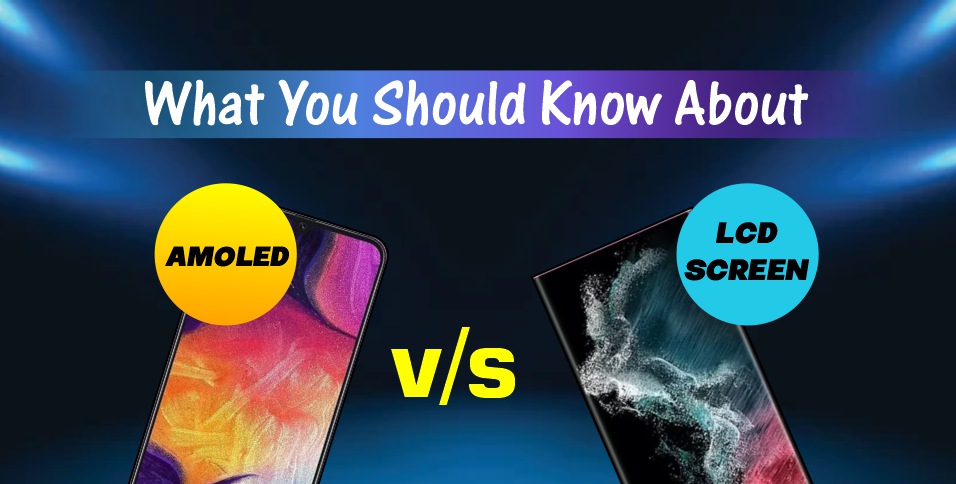The world of mobile display technology is divided between those who prefer AMOLED screens and those who prefer LCD screens. OLED technology, closely related to AMOLED displays, is available on specific mobile devices. Since the two are based on fundamentally different technologies, distinct manufacturers will promote different advantages for their chosen display technology, AMOLED or LCD. AMOLED displays are becoming the standard for smartphones, whereas LCD screens are often kept for budget models.
AMOLED Display
First, let’s talk about AMOLED, similar to OLED displays but has a few more bells and whistles. One must be familiar with each of its three parts to grasp it fully. LED, short for “Light Emitting Diode,” is the first. The “O” in OLED refers to “organic,” which describes the material used to construct the device.
To put it another way, each LED has two conductors in which organic material is inserted to assist generate light. And the “AM” in AMOLED stands for Active Matrix, which may improve a pixel’s quality. High brightness and sharpness, improved battery life, accurate colour reproduction, etc., are all features shared by the AMOLED and OLED displays. A capacitor connects each LED in an AMOLED display to a thin film transistor (TFT).
TFT is used to control each pixel in an AMOLED screen. There are probably many benefits to this presentation, but because there are also some drawbacks, I’ll mention them.
Benefits of using AMOLED displays
The benefits of using best AMOLED screen include a higher contrast ratio and more vibrant colours, which contribute to a more satisfying video-viewing experience. Individual pixels may be activated or deactivated thanks to the included LEDs. The pixels in the black area of the picture will be disabled, revealing the most accurate black possible.
The use of individual LEDs improves the efficiency of the display. You may notice an increase in battery life as a result of the fact that specific pixels aren’t using any power at all.
LCD Display
LCD stands for “Liquid Crystal Display,” and its colour output differs from that of an AMOLED screen. Instead of employing separate LED lights for every pixel, an LCD screen has its own built-in backlight.
Display backlighting in an LCD is achieved using a simple arrangement of thin films, transparent mirrors, and white LEDs.
A backlight and colour filter are necessary components of every LCD panel, as we’ve discussed. A polarizer and a matrix of thin-film transistors are required stops for the backlight on its way to the display. This means that the whole screen will be illuminated, yet only a little amount of light will really reach the viewer. This is the main distinction between AMOLED and LCD, the two most common types of electronic displays now available.
Advantages of LCD Displays
Liquid crystal displays (LCDs) have lower production costs than AMOLEDs since they need less expensive light sources. LCD screens are also often seen in low-priced cell phones.
LCDs’ whites are so luminous because the backlight pumps so much illumination into each pixel that text on these screens can be read even in direct sunlight. Aside from that, it displays “Accurate True to Life” colours, which are most faithful to how things seem in the real world.
LCDs also provide the widest field of vision. This may be dependent on the kind of smartphone you use. However, most modern LCD screens have wide viewing angles with little colour shifting or distortion.
Is AMOLED or LCD the Superior Display Technology?
There are benefits and drawbacks to each of these presentation methods. Putting those aside, everything comes down to user choice, as different individuals have different tastes in colour schemes and contrast ratios. However, there are a few considerations that may aid you in selecting the one that is most suited to your needs.
Let’s talk about the cost to begin. The cost of a smartphone with an AMOLED screen is often higher than that of a smartphone with an LCD screen. This, is despite the fact that the tide is beginning to turn. Even still,the best AMOLED screen of sufficient quality are now available on only the most expensive flagship handsets. AMOLED screens also provide very crisp and vivid colours. Additionally, they surpass the visual quality of any LCD screen. Compared to an LCD, an AMOLED screen isn’t nearly as bright. Therefore, an LCD screen performs much better when used in the open air.
Finally, we look at battery life, and no other display technology comes close to AMOLEDs in this regard. All modern smartphones include a “Dark Mode,” where the screen and app icons are black. There is no need for additional lighting while using this dark user interface, which is great for smartphones with AMOLED screens.
AMOLED screens are superior to LCD displays when compared using these criteria. In addition, major display original equipment manufacturers (OEMs) like Samsung and LG emphasise OLED technology for their next endeavours. Therefore, it is prudent to keep an eye out for AMOLED screens. However, if we witness more LCD technology improvements in battery economy and more, there is no need to cancel them at this time.
Also Read: What is the Best OTT Solution to Create VOD Service?















